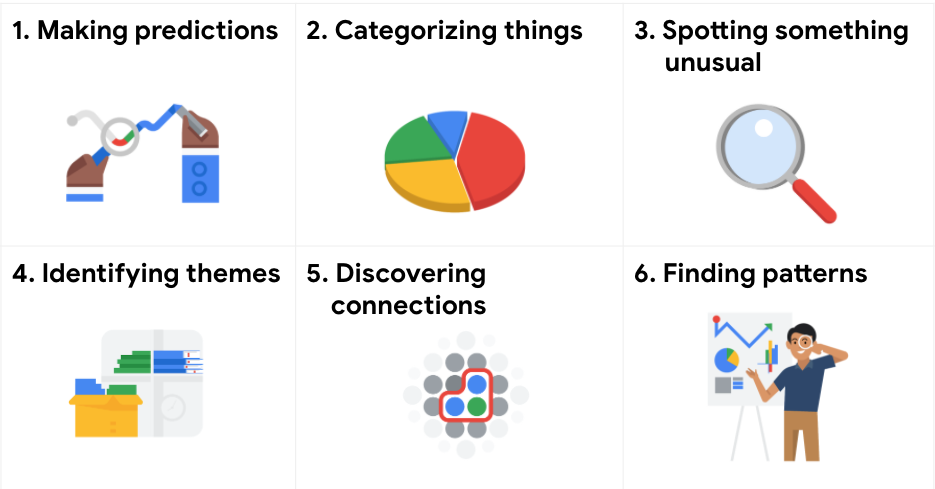Exploring the Six Common Problem Types in Data Analytics for Effective Solutions
- Trí Quang
- 2 days ago
- 3 min read
Updated: 2 days ago
Data analytics is not just about analyzing numbers; it is a powerful tool for problem-solving. In today’s data-driven world, finding effective solutions begins with a clear understanding of the problems we face. Creative thinking can transform data analysis into a strategic advantage. Whether you are looking to enhance customer experience or optimize operations, knowing how to approach data analytically is key. This post explores six common problem types in data analytics, each requiring tailored methods and skills for effective results.
1. Making Predictions
Making predictions is fundamental in data analytics. It involves using historical data to forecast future events. For instance, a retail company might analyze the last two years of promotional campaigns. By looking at which ads led to a 30% increase in new customer acquisitions, the company can better decide where to focus future marketing efforts. For example, if data shows that social media ads generated the most sales in a particular region, that insight can help allocate a higher budget for those campaigns in similar future promotions.
Predictions can significantly affect business strategies, helping companies allocate resources effectively and improve marketing ROI.
2. Categorizing Things
Categorization plays a crucial role in organizing data into useful groups. Take a telecommunications company working to improve its customer service. By analyzing call logs and categorizing calls based on issues—like billing, technical support, or service inquiries—analysts can spot trends. Suppose 60% of customer complaints relate to billing issues. This insight allows management to address specific areas, potentially leading to a 15% reduction in call volume through better bill clarity.
Organizing data this way not only simplifies analysis but also uncovers insights that drive improvements in service quality.
3. Spotting Something Unusual
Anomaly detection is essential for identifying unexpected behaviors in data. For example, a financial institution might analyze transaction patterns to flag suspicious activities. If an account typically sees a monthly average of $1,000 in transactions and suddenly shows a $10,000 withdrawal, this unusual activity can prompt immediate investigations to prevent fraud.
By using data analytics to identify such outliers, organizations can address potential issues early on, thus reducing risks.
4. Identifying Themes
Identifying themes involves analyzing data to uncover underlying trends that can guide decisions. A restaurant chain might analyze thousands of customer reviews and use text analytics to reveal common themes in feedback—like long wait times or menu variety. If 40% of negative reviews cite slow service, the company can implement strategies to reduce wait times, subsequently improving overall customer satisfaction rates.
Recognizing these themes allows businesses to tailor their offerings, ultimately enhancing customer satisfaction and loyalty.
5. Discovering Connections
Discovering connections focuses on understanding how different factors relate to each other. A university might study the correlation between student grades and attendance. By analyzing data, they could find that students with 90% attendance or more achieve grades at least 20% higher than those with lower attendance.
Such insights can drive academic policies, encouraging regular attendance through incentives that ultimately improve student outcomes.
6. Finding Patterns
Finding patterns means examining data to recognize recurring trends. For instance, an e-commerce platform analyzing customer purchasing behaviors might discover that 75% of users who buy running shoes also purchase related accessories, like socks or fitness bands. Recognizing this pattern could lead to strategic recommendations for cross-selling initiatives, increasing average order values by a projected 10-20%.
The ability to recognize and act on patterns is vital for creating data-driven marketing strategies that boost sales.
Wrapping Up
Understanding the six problem types in data analytics is crucial for fostering effective decision-making and problem-solving. By using a problem-solver approach, analysts can determine what data is relevant, how to analyze it, and how the findings can be applied.
Whether making predictions, categorizing data, spotting unusual patterns, identifying themes, discovering connections, or finding patterns, each problem type offers unique chances for insight. Mastering these types can empower organizations to utilize data analytics effectively, leading to informed decisions and successful outcomes.

By understanding these problem types, businesses can not only address immediate challenges but also set the stage for sustainable success in the evolving landscape of data analytics.



Comments